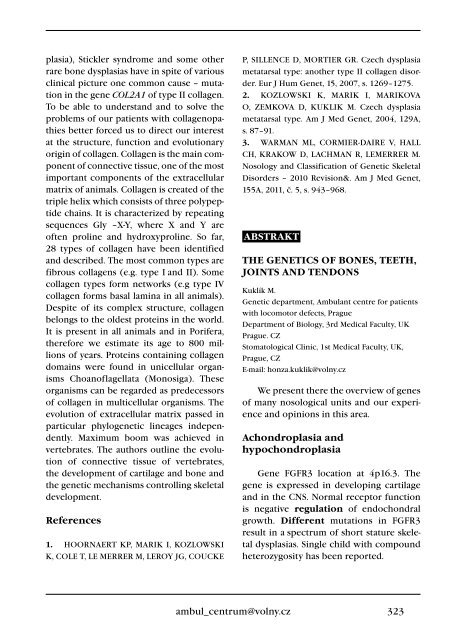3+4+Supplementum/2012 - Společnost pro pojivové tkáně
3+4+Supplementum/2012 - Společnost pro pojivové tkáně
3+4+Supplementum/2012 - Společnost pro pojivové tkáně
- TAGS
- www.pojivo.cz
You also want an ePaper? Increase the reach of your titles
YUMPU automatically turns print PDFs into web optimized ePapers that Google loves.
plasia), Stickler syndrome and some other<br />
rare bone dysplasias have in spite of various<br />
clinical picture one common cause – mutation<br />
in the gene COL2A1 of type II collagen.<br />
To be able to understand and to solve the<br />
<strong>pro</strong>blems of our patients with collagenopathies<br />
better forced us to direct our interest<br />
at the structure, function and evolutionary<br />
origin of collagen. Collagen is the main component<br />
of connective tissue, one of the most<br />
important components of the extracellular<br />
matrix of animals. Collagen is created of the<br />
triple helix which consists of three polypeptide<br />
chains. It is characterized by repeating<br />
sequences Gly –X-Y, where X and Y are<br />
often <strong>pro</strong>line and hydroxy<strong>pro</strong>line. So far,<br />
28 types of collagen have been identified<br />
and described. The most common types are<br />
fibrous collagens (e.g. type I and II). Some<br />
collagen types form networks (e.g type IV<br />
collagen forms basal lamina in all animals).<br />
Despite of its complex structure, collagen<br />
belongs to the oldest <strong>pro</strong>teins in the world.<br />
It is present in all animals and in Porifera,<br />
therefore we estimate its age to 800 millions<br />
of years. Proteins containing collagen<br />
domains were found in unicellular organisms<br />
Choanoflagellata (Monosiga). These<br />
organisms can be regarded as predecessors<br />
of collagen in multicellular organisms. The<br />
evolution of extracellular matrix passed in<br />
particular phylogenetic lineages independently.<br />
Maximum boom was achieved in<br />
vertebrates. The authors outline the evolution<br />
of connective tissue of vertebrates,<br />
the development of cartilage and bone and<br />
the genetic mechanisms controlling skeletal<br />
development.<br />
References<br />
1. HOORNAERT KP, MARIK I, KOZLOWSKI<br />
K, COLE T, LE MERRER M, LEROY JG, COUCKE<br />
ambul_centrum@volny.cz<br />
P, SILLENCE D, MORTIER GR. Czech dysplasia<br />
metatarsal type: another type II collagen disorder.<br />
Eur J Hum Genet, 15, 2007, s. 1269–1275.<br />
2. KOZLOWSKI K, MARIK I, MARIKOVA<br />
O, ZEMKOVA D, KUKLIK M. Czech dysplasia<br />
metatarsal type. Am J Med Genet, 2004, 129A,<br />
s. 87–91.<br />
3. WARMAN ML, CORMIER-DAIRE V, HALL<br />
CH, KRAKOW D, LACHMAN R, LEMERRER M.<br />
Nosology and Classification of Genetic Skeletal<br />
Disorders – 2010 Revision&. Am J Med Genet,<br />
155A, 2011, č. 5, s. 943–968.<br />
aBSTRakT<br />
THe GeneTiCS Of BOneS, TeeTH,<br />
JOinTS and TendOnS<br />
Kuklík M.<br />
Genetic department, Ambulant centre for patients<br />
with locomotor defects, Prague<br />
Department of Biology, 3rd Medical Faculty, UK<br />
Prague. CZ<br />
Stomatological Clinic, 1st Medical Faculty, UK,<br />
Prague, CZ<br />
E-mail: honza.kuklik@volny.cz<br />
We present there the overview of genes<br />
of many nosological units and our experience<br />
and opinions in this area.<br />
achondroplasia and<br />
hypochondroplasia<br />
Gene FGFR3 location at 4p16.3. The<br />
gene is expressed in developing cartilage<br />
and in the CNS. Normal receptor function<br />
is negative regulation of endochondral<br />
growth. different mutations in FGFR3<br />
result in a spectrum of short stature skeletal<br />
dysplasias. Single child with compound<br />
heterozygosity has been reported.<br />
323

















